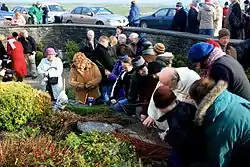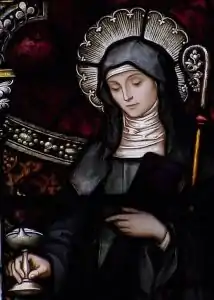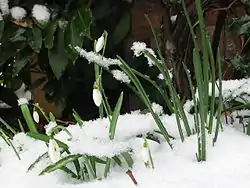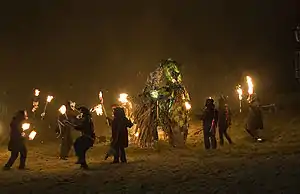Imbolc
Imbolc or Imbolg ([ɪˈmˠɔlˠɡ]), also called (Saint) Brigid's Day (Irish: Lá Fhéile Bríde, Scottish Gaelic: Là Fhèill Brìghde, Manx: Laa'l Breeshey), is a Gaelic traditional festival marking the beginning of spring. It was traditionally held on 1 February. It lands about halfway between the winter solstice and the spring equinox.[1][2] Historically, it was widely observed throughout Ireland, Scotland and the Isle of Man. It is one of the four Gaelic seasonal festivals—along with Bealtaine, Lughnasadh and Samhain.[3] For Christians, especially in Ireland, it is the feast day of Saint Brigid.
| Imbolc | |
|---|---|
| Also called | Lá Fhéile Bríde (Irish) Là Fhèill Brìghde (Scottish Gaelic) Laa'l Breeshey (Manx) |
| Observed by | Historically: Gaels Today: Irish people, Scottish people, Manx people, Celtic neopagans and Wiccans |
| Type | Cultural, Pagan (Celtic polytheism, Celtic neopaganism, Wicca) |
| Significance | beginning of spring |
| Celebrations | feasting, making Brigid's crosses and Brídeógs, visiting holy wells, divination, spring cleaning |
| Date | 1 February (or 1 August for Neopagans in the S. Hemisphere) |
| Related to | Gŵyl Fair y Canhwyllau, Candlemas, Groundhog Day |
Imbolc is mentioned in early Irish literature, and there is evidence suggesting it was also an important date in ancient times. It is believed that Imbolc was originally a pagan festival associated with the goddess Brigid, and that it was Christianized as a festival of Saint Brigid, who is thought to be a Christianization of the goddess.[4] On Imbolc/St Brigid's Day, Brigid's crosses were made and a doll-like figure of Brigid (a Brídeóg) would be paraded from house-to-house by girls, sometimes accompanied by 'strawboys'. Brigid was said to visit one's home at Imbolc. To receive her blessings, people would make a bed for Brigid and leave her food and drink, and items of clothing would be left outside for her to bless. Brigid was also evoked to protect homes and livestock. Special feasts were had, holy wells were visited, and it was a time for divination.
Although many of its customs died out in the 20th century, it is still observed and in some places it has been revived as a cultural event. Since the latter 20th century, Celtic neopagans and Wiccans have observed Imbolc as a religious holiday.[1][2]
Etymology
The etymology of Imbolc/Imbolg is unclear. The most common explanation is that it comes from the Old Irish i mbolc (Modern Irish: i mbolg), meaning 'in the belly', and refers to the pregnancy of ewes.[5] Another possible origin is the Old Irish imb-fholc, 'to wash/cleanse oneself', referring to a ritual cleansing.[6] Eric P. Hamp derives it from a Proto-Indo-European root meaning both 'milk' and 'cleansing'.[7] Professor Alan Ward derives it from the Proto-Celtic *embibolgon, 'budding'.[8] The 10th century Cormac's Glossary derives it from oimelc, 'ewe milk',[9] but many scholars see this as a folk etymology. Nevertheless, some Neopagans have adopted Oimelc as a name for the festival.
Since Imbolc is immediately followed (on 2 February) by Candlemas (Irish: Lá Fhéile Muire na gCoinneal, 'feast day of Mary of the Candles', Welsh: Gŵyl Fair y Canhwyllau),[10] Irish Imbolc is sometimes translated into English as Candlemas; e.g. "iar n-imbulc, ba garb a ngeilt" translated as "after Candlemas, rough was their herding".[11]
Origins
The date of Imbolc is thought to have been significant in Ireland since the Neolithic period.[12] Some passage tombs in Ireland are aligned with the sunrise around the times of Imbolc and Samhain. This includes the Mound of the Hostages on the Hill of Tara,[13][14] and Cairn L at Slieve na Calliagh.[15]
Historic customs
In Gaelic Ireland, Imbolc was the feis or festival marking the beginning of spring, during which great feasts were held. It is attested in some of the earliest Old Irish literature, from the 10th century onward. It was one of four Gaelic seasonal festivals: Samhain (~1 November), Imbolc (~1 February), Beltane (~1 May) and Lughnasadh (~1 August).
From the 18th century to the mid 20th century, many accounts of Imbolc or St Brigid's Day were recorded by folklorists and other writers. They tell us how it was celebrated then, and shed light on how it may have been celebrated in the past.[2][16]

Imbolc has traditionally been celebrated on 1 February. However, because the day was deemed to begin and end at sunset, the celebrations would start on what is now 31 January. It has also been argued that the timing of the festival was originally more fluid and based on seasonal changes. It has been associated with the onset of the lambing season[17] (which could vary by as much as two weeks before or after 1 February),[5] the beginning of the spring sowing,[18] and the blooming of blackthorn.[19]
The holiday was a festival of the hearth and home, and a celebration of the lengthening days and the early signs of spring. Celebrations often involved hearthfires, special foods, divination or watching for omens, candles or a bonfire if the weather permitted.[1][20] Fire and purification were an important part of the festival. The lighting of candles and fires represented the return of warmth and the increasing power of the Sun over the coming months.[5] A spring cleaning was also customary.[21]
Holy wells were visited at Imbolc, and at the other Gaelic festivals of Beltane and Lughnasa. Visitors to holy wells would pray for health while walking 'sunwise' around the well. They would then leave offerings, typically coins or clooties (see clootie well). Water from the well was used to bless the home, family members, livestock and fields.[21][22]
Donald Alexander Mackenzie also recorded that offerings were made "to earth and sea". The offering could be milk poured into the ground or porridge poured into the water, as a libation.[23]
Brigid

Imbolc is strongly associated with Saint Brigid (Old Irish: Brigit, modern Irish: Bríd, modern Scottish Gaelic: Brìghde or Brìd, anglicised Bridget). Saint Brigid is thought to have been based on Brigid, a Gaelic goddess.[24] The festival, which celebrates the onset of spring, is thought to be linked with Brigid in her role as a fertility goddess.[17]
On Imbolc Eve, Brigid was said to visit virtuous households and bless the inhabitants.[25] As Brigid represented the light half of the year, and the power that will bring people from the dark season of winter into spring, her presence was very important at this time of year.[20][26]
Families would have a special meal or supper on Imbolc Eve. This typically included food such as colcannon, sowans, dumplings, barmbrack or bannocks.[21] Often, some of the food and drink would be set aside for Brigid.[25]
Brigid would be symbolically invited into the house and a bed would often be made for her. In the north of Ireland a family member, representing Brigid, would circle the home three times carrying rushes. They would then knock the door three times, asking to be let in. On the third attempt they are welcomed in, the meal is had, and the rushes are then made into a bed or crosses.[27] In 18th century Mann, the custom was to stand at the door with a bundle of rushes and say "Brede, Brede, come to my house tonight. Open the door for Brede and let Brede come in". The rushes were then strewn on the floor as a carpet or bed for Brigid. In the 19th century, some old Manx women would make a bed for Brigid in the barn with food, ale, and a candle on a table.[25] In the Hebrides in the late 18th century, a bed of hay would be made for Brigid and someone would then call out three times: "a Bhríd, a Bhríd, thig a stigh as gabh do leabaidh" ("Bríd Bríd, come in; thy bed is ready").[25] A white wand, usually made of birch, would be set by the bed. It represented the wand that Brigid was said to use to make the vegetation start growing again.[28] In the 19th century, women in the Hebrides would dance while holding a large cloth and calling out "Bridean, Bridean, thig an nall 's dean do leabaidh" ("Bríd, Bríd, come over and make your bed"). However, by this time the bed itself was rarely made.[25]
Before going to bed, people would leave items of clothing or strips of cloth outside for Brigid to bless.[25] Ashes from the fire would be raked smooth and, in the morning, they would look for some kind of mark on the ashes as a sign that Brigid had visited.[25][29] The clothes or strips of cloth would be brought inside, and believed to now have powers of healing and protection.[20][26]

In Ireland and Scotland, a representation of Brigid would be paraded around the community by girls and young women. Usually it was a doll-like figure known as a Brídeóg (also called a 'Breedhoge' or 'Biddy'). It would be made from rushes or reeds and clad in bits of cloth, flowers or shells.[25][29] In the Hebrides of Scotland, a bright shell or crystal called the reul-iuil Bríde (guiding star of Brigid) was set on its chest. The girls would carry it in procession while singing a hymn to Brigid. All wore white with their hair unbound as a symbol of purity and youth. They visited every house in the area, where they received either food or more decoration for the Brídeóg. Afterwards, they feasted in a house with the Brídeóg set in a place of honour, and put it to bed with lullabies. In the late 17th century, Catholic families in the Hebrides would make a bed for the Brídeóg out of a basket.[25] When the meal was done, the local young men humbly asked for admission, made obeisance to the Brídeóg, and joined the girls in dancing and merrymaking.[25] In many places, only unwed girls could carry the Brídeóg, but in some both boys and girls carried it.[30] Sometimes, rather than carrying a Brídeóg, a girl took on the role of Brigid. Escorted by other girls, she went house-to-house wearing 'Brigid's crown' and carrying 'Brigid's shield' and 'Brigid's cross', all of which were made from rushes.[31] The procession in some places included 'strawboys', who wore conical straw hats, masks and played folk music; much like the wrenboys.[31] Up until the mid-20th century, children in Ireland still went house-to-house asking for pennies for "poor Biddy", or money for the poor. In County Kerry, men in white robes went from house to house singing.[32]
In Ireland, Brigid's crosses (pictured on the right) were made at Imbolc. A Brigid's cross usually consists of rushes woven into a four-armed equilateral cross, although three-armed crosses have also been recorded.[33][34] They were often hung over doors, windows and stables to welcome Brigid and for protection against fire, lightning, illness and evil spirits.[31] The crosses were generally left there until the next Imbolc.[25] In western Connacht, people would make a Crios Bríde (Bríd's girdle); a great ring of rushes with a cross woven in the middle. Young boys would carry it around the village, inviting people to step through it and so be blessed.[25]
Today, some people still make Brigid's crosses and Brídeógs or visit holy wells dedicated to St Brigid on 1 February.[35] Brigid's Day parades have been revived in the town of Killorglin, County Kerry, which holds a yearly "Biddy's Day Festival". Men and women wearing elaborate straw hats and masks visit public houses carrying a Brídeóg to bring good luck for the coming year. They play folk music, dance and sing. The highlight of this festival is a torchlight parade through the town followed by a song and dance contest.[36]
Weather divination

Imbolc was traditionally a time of weather divination, and the old tradition of watching to see if serpents or badgers came from their winter dens may be a forerunner of the North American Groundhog Day. A Scottish Gaelic proverb about the day is:
Thig an nathair as an toll |
The serpent will come from the hole |
Imbolc was believed to be when the Cailleach—the divine hag of Gaelic tradition—gathers her firewood for the rest of the winter. Legend has it that if she wishes to make the winter last a good while longer, she will make sure the weather on Imbolc is bright and sunny, so she can gather plenty of firewood. Therefore, people would be relieved if Imbolc is a day of foul weather, as it means the Cailleach is asleep and winter is almost over.[38] At Imbolc on the Isle of Man, where she is known as Caillagh ny Groamagh, the Cailleach is said to take the form of a gigantic bird carrying sticks in her beak.[38]
Neopaganism

Imbolc or Imbolc-based festivals are held by some Neopagans. As there are many kinds of Neopaganism, their Imbolc celebrations can be very different despite the shared name. Some try to emulate the historic festival as much as possible. Other Neopagans base their celebrations on many sources, with historic accounts of Imbolc being only one of them.[39][40]
Neopagans usually celebrate Imbolc on 1 February in the Northern Hemisphere and 1 August in the Southern Hemisphere.[41][42][43][44] Some Neopagans celebrate it at the astronomical midpoint between the winter solstice and spring equinox (or the full moon nearest this point). In the Northern Hemisphere, this is usually on 3 or 4 February.[45] Other Neopagans celebrate Imbolc when the primroses, dandelions, and other spring flowers emerge.[46]
Celtic Reconstructionist
Celtic Reconstructionists strive to reconstruct the pre-Christian religions of the Celts. Their religious practices are based on research and historical accounts,[47][48] but may be modified slightly to suit modern life. They avoid syncretism (i.e. combining practises from different cultures). They usually celebrate the festival when the first stirrings of spring are felt, or on the full moon nearest this. Many use traditional songs and rites from sources such as The Silver Bough and The Carmina Gadelica. It is a time of honouring the Goddess Brigid, and many of her dedicants choose this time of year for rituals to her.[47][48]
Wicca and Neo-Druidry
Wiccans and Neo-Druids celebrate Imbolc as one of the eight Sabbats in their Wheel of the Year, following Midwinter and preceding Ostara. In Wicca, Imbolc is commonly associated with the goddess Brigid and as such it is sometimes seen as a "women's holiday" with specific rites only for female members of a coven.[49] Among Dianic Wiccans, Imbolc is the traditional time for initiations.[50]
References
- Danaher, Kevin (1972) The Year in Ireland: Irish Calendar Customs Dublin, Mercier. ISBN 1-85635-093-2 p. 38
- McNeill, F. Marian (1959, 1961) The Silver Bough, Vol. 1–4. William MacLellan, Glasgow; Vol. 2, pp. 11–42
- Cunliffe, Barry (1997). The Ancient Celts. Oxford: Oxford University Press. Page 188-190.
- Berger, Pamela (1985). The Goddess Obscured: Transformation of the Grain Protectress from Goddess to Saint. Boston: Beacon Press. pp. 70–73. ISBN 9780807067239.
- Chadwick, Nora K. (1970). The Celts. Harmondsworth: Penguin. p. 181. ISBN 0-14-021211-6.
- Wright, Brian. Brigid: Goddess, Druidess and Saint. The History Press, 2011. p. 83
- Hamp, Eric (1979–80). "Imbolc, Óimelc". Studia Celtica (14/15): 106–113.
- Ward, Alan (2011). The Myths of the Gods: Structures in Irish Mythology. p. 15. Archived from the original on 30 January 2017 – via CreateSpace.
- Meyer, Kuno, Sanas Cormaic: an Old-Irish Glossary compiled by Cormac úa Cuilennáin, King-Bishop of Cashel in the ninth century (1912).
- MacKillop, James (1998). Dictionary of Celtic mythology. Oxford: Oxford University Press. p. 270. ISBN 0-19-280120-1.
- Gwynn, Edward John, MRIA (1868–1941), The Metrical dindshenchas, Royal Irish Academy, Dublin, 1903–1935, iii 370.61.
- "Imbolc". Newgrange UNESCO World Heritage website. Retrieved 1 June 2011.
- Knowth.com photo of Samhain sunrise at the Mound of Hostages "The Stone Age Mound of the Hostages is also aligned with the Samhain sun rise." The sun rises from the same angle on Imbolc.
- Murphy, Anthony. "Mythical Ireland – Ancient Sites – The Hill of Tara – Teamhair". Mythical Ireland – New light on the ancient past. Retrieved 15 January 2018.
- Brennan, Martin. The Stones of Time: Calendars, Sundials, and Stone Chambers of Ancient Ireland. Inner Traditions, 1994. pp. 110–11
- Danaher, Kevin (1972) The Year in Ireland: Irish Calendar Customs Dublin, Mercier. ISBN 1-85635-093-2 pp. 200–229
- Koch, John T. Celtic Culture: A Historical Encyclopedia. 2006. p. 287.
- Danaher, The Year in Ireland, p.13
- Aveni, Anthony F. (2004). The Book of the Year: A Brief History of Our Seasonal Holidays. Oxford University Press, USA. p. 38. ISBN 0-19-517154-3.
- McNeill, F. Marian (1959) The Silver Bough, Vol. 1,2,4. William MacLellan, Glasgow
- Danaher, The Year in Ireland, p. 15.
- Monaghan, p. 41.
- Mackenzie, Donald. Wonder Tales from Scottish Myth and Legend (1917). p. 19.
- MacKillop, James (1998). Dictionary of Celtic mythology. Oxford University Press. p. 58. ISBN 0-19-280120-1.
- Hutton, Ronald (1996). Stations of the Sun: A History of the Ritual Year in Britain. Oxford University Press. pp. 135–138. ISBN 9780198205708.
- "Carmina Gadelica Vol. 1: II. Aimsire: Seasons: 70 (notes). Genealogy of Bride. Sloinntireachd Bhride". Sacred-texts.com. Retrieved 15 January 2018.
- Danaher, The Year in Ireland, pp. 20–21, 97–98
- Carmichael, Carmina Gadelica, p. 582
- Monaghan, Patricia. The Encyclopedia of Celtic Mythology and Folklore. Infobase Publishing, 2004. p. 256.
- Monaghan, p. 58.
- Danaher, The Year in Ireland, pp.22–25
- Monaghan, p. 44.
- Ó Duinn, Seán (2005). The Rites of Brigid: Goddess and Saint. Dublin: Columba Press. p. 121. ISBN 978-1856074834.
- Evans, Emyr Estyn. Irish Folk Ways, 1957. p. 268
- Monaghan, p. 60.
- "Home". Biddy's Day. Archived from the original on 29 March 2018. Retrieved 15 January 2018.
- Carmichael, Alexander (1900) Carmina Gadelica: Hymns and Incantations, Ortha Nan Gaidheal, Volume I, p. 169 The Sacred Texts Archive
- Briggs, Katharine (1976) An Encyclopedia of Fairies. New York, Pantheon Books., pp. 57–60
- Adler, Margot (1979) Drawing Down the Moon: Witches, Druids, Goddess-Worshippers, and Other Pagans in America Today. Boston, Beacon Press ISBN 0-8070-3237-9. p. 3
- McColman, Carl (2003) Complete Idiot's Guide to Celtic Wisdom. Alpha Press ISBN 0-02-864417-4. p. 51
- Nevill Drury (2009). "The Modern Magical Revival: Esbats and Sabbats". In Pizza, Murphy; Lewis, James R (eds.). Handbook of Contemporary Paganism. Leiden, Netherlands: Brill Publishers. pp. 63–67. ISBN 9789004163737.
- Hume, Lynne (1997). Witchcraft and Paganism in Australia. Melbourne: Melbourne University Press. ISBN 9780522847826.
- Vos, Donna (2002). Dancing Under an African Moon: Paganism and Wicca in South Africa. Cape Town: Zebra Press. pp. 79–86. ISBN 9781868726530.
- Bodsworth, Roxanne T (2003). Sunwyse: Celebrating the Sacred Wheel of the Year in Australia. Victoria, Australia: Hihorse Publishing. ISBN 9780909223038.
- "archaeoastronomy.com explains the reason we have seasons". Archaeoastronomy.com. Retrieved 15 January 2018.
- Bonewits, Isaac (2006) Bonewits's Essential Guide to Druidism. New York, Kensington Publishing Group ISBN 0-8065-2710-2. pp. 184–5
- McColman, Carl (2003) p. 12
- Bonewits (2006) pp. 130–7
- Gallagher, Ann-Marie (2005). The Wicca Bible: The Definitive Guide to Magic and the Craft. London: Godsfield Press. Page 63.
- Budapest, Zsuzsanna (1980) The Holy Book of Women's Mysteries ISBN 0-914728-67-9
Further reading
- Carmichael, Alexander (1992) Carmina Gadelica: Hymns and Incantations (with illustrative notes on wards, rites, and customs dying and obsolete/ orally collected in the Highlands and Islands of Scotland) Hudson, NY, Lindisfarne Press, ISBN 0-940262-50-9
- Chadwick, Nora (1970) The Celts London, Penguin. ISBN 0-14-021211-6
- Danaher, Kevin (1972) The Year in Ireland. Dublin, Mercier. ISBN 1-85635-093-2
- McNeill, F. Marian (1959) The Silver Bough, Vol. 1–4. William MacLellan, Glasgow
- Ó Catháin, Séamas (1995) Festival of Brigit
External links
| Look up Imbolc in Wiktionary, the free dictionary. |
- Introduction to Celtic Majesty of Brigid – The Feast of Imbolg
- The Festival of Brigit the Holy Woman (Oiche Fhéile Bríde agus Lá Lúnasa)
- Imbolc lore from the Carmina Gadelica
- Francine Nicholson. "Imbolc in Yesterday's Ireland and Scotland". Celtic Well. Archived from the original on 4 February 2012. Retrieved 1 February 2006.
- Imbolc (Imbolg) and Candlemas – Witches' Sabbat and Pagan Tradition
- Lá Féile Bríde – Kildare Education Centre
- Lá Fhéile Bríde Archived 3 September 2006 at the Wayback Machine – Celtic Reconstructionist Imbolg Ritual
- Saint Brigid & Spring – bilingual, Irish folklore
Modern events
- Imbolc Fire Festival – Marsden, Huddersfield by Gary Stevenson
- Imbolc – Inspiration for the Year – Conference as gaeilge, Ionad Cultúrtha, Ballyvourney, Co. Cork.

